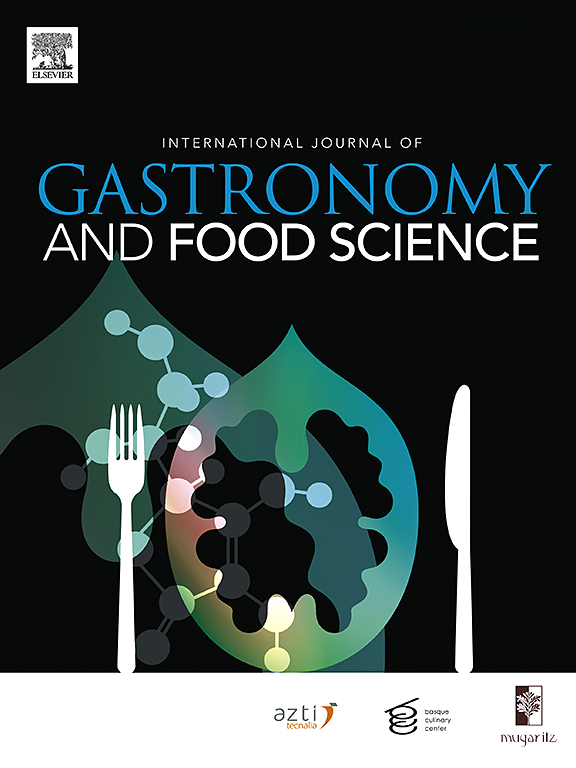An innovative approach of 3D printed functional foods: Grasshoppers based cookies
IF 3.2
2区 农林科学
Q2 FOOD SCIENCE & TECHNOLOGY
International Journal of Gastronomy and Food Science
Pub Date : 2025-03-03
DOI:10.1016/j.ijgfs.2025.101137
引用次数: 0
Abstract
Supplements can be used to enhance the nutritional properties of food. Combining these supplements with 3D printing technology has the potential to increase food variation by facilitating food processibility. In this paper, we provide some trailblazing examples to develop protein-rich cookies using 3D printing as a processing method to support sustainable food sources and to reduce prejudice towards edible insects. The cookies were printed in 3 groups as: tasteless(T), salty(S1) and sugary(S2). Freeze drying was used as post-process to extend the shelf life of the cookies and provide a crispy structure. Printability and the effects of salt and sugar addition on the rheological properties of the grasshopper powder-added paste were investigated. The printed cookie samples were characterised by Fourier transform infrared spectroscopy (ATR-FT-IR), Scanning electron microscopy (SEM), texture measurements, nitrogen content and crude protein determination, colour analysis and sensory analysis.
Rheology analysis revealed that S1 and S2 pastes exhibit an elastic behaviour as a solid material (G’ > G″) while the T paste exhibits a viscous behaviour as a liquid (G’’ > G’). Quantitative printability testing by examining the pore structure of 3D-printed cookies confirmed that all pastes were printable in high quality. Characteristic peaks of grasshopper powder were detected for each cookie according to chemical evolution. Morphological analysis demonstrated that grasshopper powder was encapsulated into the cookies. Moreover, the surface of the T and S2 samples was close to a smoother appearance, but more cracks were observed on the surface of the S1 cookie related to the salt content. According to the crude protein test results, it was seen that cookies with high protein content were produced (25.00% ± 0.35 for sample T). Colour analysis showed that there were no significant differences between samples. Textural evaluation showed that salt and sugar added increased the hardness, adhesiveness, springiness, cohesiveness, and resilience. Sensory analysis attributes of the sugar-added product is the most preferred sample according to crispiness, flavour and overall preference criteria than the other two samples. The results of this study demonstrated that production with integration of 3D printing and freeze-drying technology can produce a shelf-stable snack food as a supplement product.

求助全文
约1分钟内获得全文
求助全文
来源期刊

International Journal of Gastronomy and Food Science
Social Sciences-Cultural Studies
CiteScore
5.30
自引率
10.50%
发文量
170
审稿时长
45 days
期刊介绍:
International Journal of Gastronomy and Food Science is a peer-reviewed journal that explicitly focuses on the interface of food science and gastronomy. Articles focusing only on food science will not be considered. This journal equally encourages both scientists and chefs to publish original scientific papers, review articles and original culinary works. We seek articles with clear evidence of this interaction. From a scientific perspective, this publication aims to become the home for research from the whole community of food science and gastronomy.
IJGFS explores all aspects related to the growing field of the interaction of gastronomy and food science, in areas such as food chemistry, food technology and culinary techniques, food microbiology, genetics, sensory science, neuroscience, psychology, culinary concepts, culinary trends, and gastronomic experience (all the elements that contribute to the appreciation and enjoyment of the meal. Also relevant is research on science-based educational programs in gastronomy, anthropology, gastronomic history and food sociology. All these areas of knowledge are crucial to gastronomy, as they contribute to a better understanding of this broad term and its practical implications for science and society.
 求助内容:
求助内容: 应助结果提醒方式:
应助结果提醒方式:


